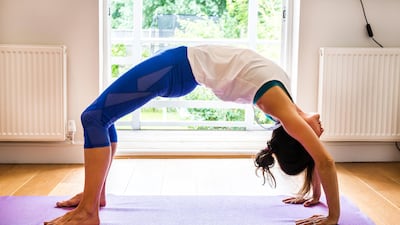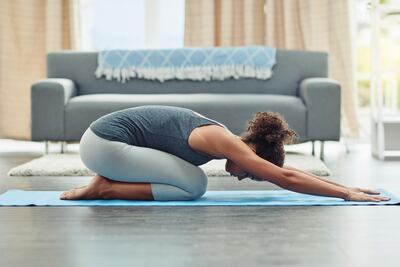Few of us expected to be working from home for as long as we have been, and no one can know when this constantly changing situation will end. But even as we play the anxious waiting and guessing game, we can all agree on one thing: most of our houses are woefully ill-prepared to handle extended periods of trying to get work done, especially by several members of the family.
The result being, despite our best efforts, the temptation to sprawl across the couch or bed at awkward angles, while trying to find that sweet spot: comfort and a videoconference-worthy backdrop.
The collateral damage in this stopgap way of working is our long-suffering spine. It might be some time before we can go back to our ergonomic chairs with lumbar support and memory foam cushions (or be in a position to bring them home). So we speak to three fitness trainers for easy, equipment-free exercises to strengthen the back and help alleviate any spinal distress caused by makeshift workstations.
Nam Wook Kang, a Bollywood celebrity fitness trainer from Mumbai, advises first fixing your neck. “Stand with your shoulder blades and back against the wall, look down to the floor, tuck your chin to the maximum then push your head back up against the wall. Imagine there is a string pulling you up from the top of your head towards the ceiling. Try to hold this position for 15 to 20 seconds, take a short break, and repeat three times.”
Next, he says, move to the upper back. “Go on the floor in a quadruped position [on hands and knees], placing your hands under the shoulders and knees under the belly button. The spine needs to be in a neutral position. Retract your shoulder blades while breathing in, and protract them while breathing out. Complete the process in a slow and precise manner, keeping your core tight. Repeat 10 times.”
Kang then brings the focus on the thoracic spine – the midsection with the c-shaped curve – and finally the lower back. For the thoracic area, your starting position needs to be the same as for the upper back exercise – on hands and knees. “Place your right hand behind your head, rotate your right elbow towards your left arm until it reaches it. Hold for two seconds then reverse the rotation towards your right. Bring your right elbow and shoulder as high as possible, with your chest facing your right side. Hold for two seconds then repeat the movement 10 times, twice on each side.
Nick Mitchell, founder of Ultimate Performance in Dubai, shares five postures that can strengthen and relieve the back muscles.
Dead bug: lie on your back with your knees and arms in the air. Keep the knees bent at a 90-degree angle. Lower your left leg to the floor slowly, lightly touching your heel to the floor. Simultaneously, lower your right arm to the floor over your head, until your fingers graze the ground. Slowly come back to the centre, then repeat with the opposite leg and arm. This will work the core abdominal muscles and help support the spine by ensuring you have a strong connection between your hips and the rib cage. Try doing this exercise 10 to 12 times on each side.
Four-point kneeling Superman: start this exercise on all fours. Kick your left leg back and your right arm forward at the same time. Make sure your spine stays straight. Slowly bring them back down to the ground and repeat with the opposite arm and leg. Repeat this exercise 10 to 12 times on each side. This will help strengthen and stabilise the core, pelvis and shoulders, while also improving bone strength.
Glute bridge: lie on your back with your heels close to your buttocks, squeeze your buttocks and lift your hips towards the ceiling as high as you can so you have a straight line between your knee, hips and shoulders, then lower your hands to your feet. Hold the position for two seconds then come back to the initial position slowly. This works to strengthen the muscles that stabilise the hips, which in turn supports the vertebrae and base of the spine. Repeat 12 to 15 times.
Basic plank: lie face down on the floor, then raise your body using your forearms and come up on your toes. Hold this position for 30 seconds to a minute. This will strengthen the core, which will support the back. If you are new to training, do two sets of planks, with 30 to 45 seconds of rest between each, and try going up to four sets when you can.
Child's pose: this is more of a stretch, often practised in yoga. You start on all fours and then just sit back on your heels, with your arms outstretched, touching the floor, and try to stretch your arms as far as you can in front of you. Hold the pose for 30 to 60 seconds. This will help stretch the muscles in the lower back. Like the plank, do two sets with 30 seconds of rest between each.
Another popular yoga posture is the cat stretch, which is recommended by Omar Al Duri, author of Reset and host of the Halftime Show on Pulse 95 Radio. "Start on all fours, with your wrists directly under the shoulders and your palms flat and fingers splayed. Your knees should be under the hips. Take a deep breath. When exhaling, push your belly towards your spine, using the force of your core. Your back should be curved towards the ceiling, literally the way a cat stretches. Hold the pose for 10 to 15 seconds and release your body to come back to the tabletop position. Repeat three to four times. This exercise will stretch your neck, chest and back, and improve your posture by relieving spine stress," says Al Duri.
His second go-to routine is the dorsal raise. “Lie face down on a yoga mat or slightly cushioned surface. Your thighs should touch the ground. Bring your hands to your temples or rest them on your back. Slowly, lift your upper body away from the floor using your spine and lower back. Make sure you do not use your arms, legs or hands to do the lifting. This exercise is great for the core and to stretch out and relieve lower back muscles tightened by bad posture.”



